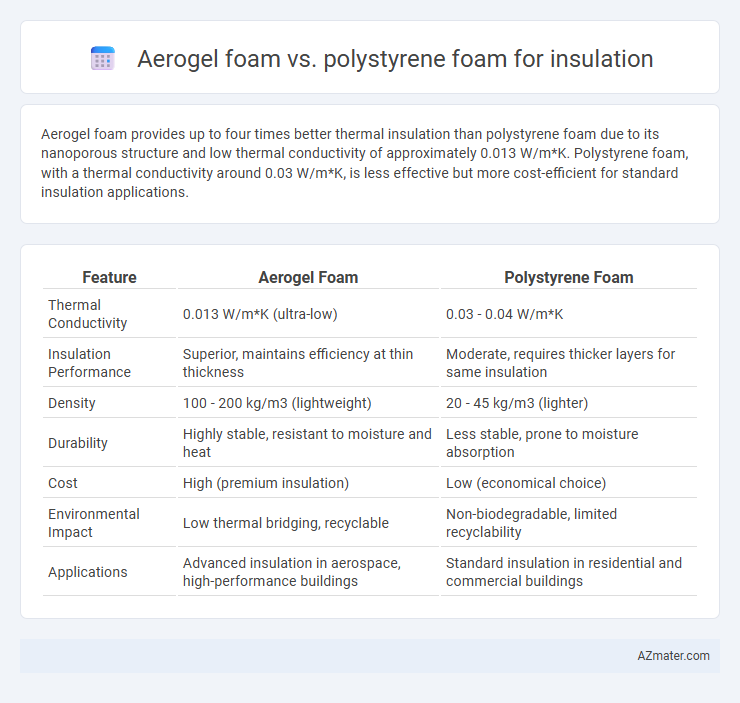Aerogel foam provides up to four times better thermal insulation than polystyrene foam due to its nanoporous structure and low thermal conductivity of approximately 0.013 W/m*K. Polystyrene foam, with a thermal conductivity around 0.03 W/m*K, is less effective but more cost-efficient for standard insulation applications.
Table of Comparison
| Feature | Aerogel Foam | Polystyrene Foam |
|---|---|---|
| Thermal Conductivity | 0.013 W/m*K (ultra-low) | 0.03 - 0.04 W/m*K |
| Insulation Performance | Superior, maintains efficiency at thin thickness | Moderate, requires thicker layers for same insulation |
| Density | 100 - 200 kg/m3 (lightweight) | 20 - 45 kg/m3 (lighter) |
| Durability | Highly stable, resistant to moisture and heat | Less stable, prone to moisture absorption |
| Cost | High (premium insulation) | Low (economical choice) |
| Environmental Impact | Low thermal bridging, recyclable | Non-biodegradable, limited recyclability |
| Applications | Advanced insulation in aerospace, high-performance buildings | Standard insulation in residential and commercial buildings |
Introduction to Thermal Insulation Materials
Aerogel foam offers superior thermal insulation due to its extremely low thermal conductivity of approximately 0.013 W/m*K, surpassing traditional polystyrene foam, which has a thermal conductivity around 0.03 W/m*K. The nanostructured composition of aerogel enables minimal heat transfer through conduction, convection, and radiation, making it ideal for applications requiring high-performance insulation with minimal thickness. Polystyrene foam remains popular for cost-effective insulation, but its higher density and lower insulating efficiency limit its use in environments where space and maximum thermal resistance are critical.
Understanding Aerogel Foam: Composition and Structure
Aerogel foam consists of a highly porous, lightweight silicon-based structure with over 90% air content, providing exceptional thermal insulation due to its low thermal conductivity. Unlike polystyrene foam, which is a rigid polymer composed of expanded polystyrene beads, aerogel foam exhibits a nanostructured matrix that minimizes heat transfer through conduction, convection, and radiation. This unique composition and structure make aerogel foam significantly more efficient for insulation in extreme environments while maintaining superior durability and fire resistance.
Overview of Polystyrene Foam: Types and Properties
Polystyrene foam, commonly available as Expanded Polystyrene (EPS) and Extruded Polystyrene (XPS), offers distinct insulation properties and benefits. EPS features a lower density and is cost-effective with good thermal resistance, while XPS provides higher compressive strength, moisture resistance, and superior R-values. Both types are widely used in construction and packaging, but XPS is often preferred for exterior applications due to its durability under environmental stress.
Thermal Conductivity Comparison: Aerogel vs Polystyrene
Aerogel foam exhibits a thermal conductivity as low as 0.013 W/m*K, significantly outperforming polystyrene foam, which typically ranges between 0.030 and 0.040 W/m*K. This ultra-low thermal conductivity makes aerogel an exceptionally effective insulator, providing superior thermal resistance in thinner layers compared to polystyrene. Consequently, aerogel foam is preferred for applications where maximum insulation efficiency and space savings are critical.
Insulation Performance in Real-World Applications
Aerogel foam offers superior insulation performance compared to polystyrene foam, providing thermal conductivity as low as 0.013 W/m*K versus polystyrene's typical range of 0.030-0.040 W/m*K, making it highly effective in real-world applications requiring extreme temperature control. Its nanoporous structure enables exceptional thermal resistance and minimal heat transfer, ideal for energy-efficient building envelopes and cryogenic insulation. Polystyrene foam, while cost-effective and widely used, often falls short in long-term durability and moisture resistance, limiting its insulating efficiency in humid or variable conditions.
Moisture Resistance and Durability
Aerogel foam offers superior moisture resistance compared to polystyrene foam due to its hydrophobic properties that prevent water absorption and maintain insulation performance over time. In terms of durability, aerogel foam exhibits exceptional thermal stability and resistance to compression, ensuring long-lasting insulation even in harsh environments. Conversely, polystyrene foam is more prone to moisture infiltration and physical degradation, which can compromise its insulating effectiveness and structural integrity.
Fire Safety and Chemical Stability
Aerogel foam exhibits superior fire safety due to its high thermal resistance and non-combustible nature, significantly outperforming polystyrene foam which is highly flammable and releases toxic gases upon burning. Chemically, aerogel maintains stability under harsh environmental conditions and resists degradation from moisture and UV exposure, whereas polystyrene foam is prone to chemical breakdown and embrittlement over time. The enhanced fire retardancy and chemical durability of aerogel foam make it a safer, longer-lasting choice for insulation applications requiring stringent safety standards.
Environmental Impact and Sustainability
Aerogel foam demonstrates superior environmental benefits over polystyrene foam due to its higher thermal efficiency, which reduces energy consumption and associated carbon emissions in buildings. Unlike polystyrene, Aerogel is less toxic, more durable, and often composed of silica, enabling easier recycling and lower long-term environmental footprint. Polystyrene foam, derived from petroleum-based products, poses significant challenges in biodegradability and contributes to persistent plastic pollution, making Aerogel a more sustainable choice for insulation.
Cost Analysis and Market Availability
Aerogel foam offers superior insulation performance with R-values up to 10 per inch but comes at a significantly higher cost, often exceeding $20 per square foot, compared to polystyrene foam, which costs around $0.50 to $2 per square foot. While aerogel insulation is ideal for high-performance applications in aerospace and industrial sectors, its limited market availability and manufacturing complexities restrict widespread adoption. Polystyrene foam remains the dominant choice in residential and commercial construction due to its affordability, easier installation, and broad availability from numerous suppliers globally.
Choosing the Right Insulation: Key Considerations
Aerogel foam offers superior thermal insulation with an R-value of approximately 10 per inch, significantly outperforming polystyrene foam, which typically ranges from R-3.6 to R-5 per inch. When choosing the right insulation, factors such as thermal resistance, space constraints, moisture resistance, and long-term durability are crucial; aerogel's low density and hydrophobic properties make it ideal for limited spaces and humid environments. Cost-effectiveness and ease of installation also influence decisions, with polystyrene being more affordable and widely available but less efficient in extreme temperature applications.

Infographic: Aerogel foam vs Polystyrene foam for Insulation
 azmater.com
azmater.com